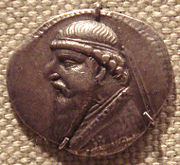
Mithridates II of Parthia
Encyclopedia


Parthian Empire
The Parthian Empire , also known as the Arsacid Empire , was a major Iranian political and cultural power in ancient Persia...
from 123 to 88 BC. His name invokes the protection of Mithra
Mithra
Mithra is the Zoroastrian divinity of covenant and oath. In addition to being the divinity of contracts, Mithra is also a judicial figure, an all-seeing protector of Truth, and the guardian of cattle, the harvest and of The Waters....
. He adopted the title Epiphanes, "god manifest" and introduced new designs on his extensive coinage.
Parthia reached its greatest extent during his reign. He saved the kingdom from the Saka
Saka
The Saka were a Scythian tribe or group of tribes....
tribes, who occupied Bactria
Bactria
Bactria and also appears in the Zend Avesta as Bukhdi. It is the ancient name of a historical region located between south of the Amu Darya and west of the Indus River...
and the east
East
East is a noun, adjective, or adverb indicating direction or geography.East is one of the four cardinal directions or compass points. It is the opposite of west and is perpendicular to north and south.By convention, the right side of a map is east....
of Iran
Iran
Iran , officially the Islamic Republic of Iran , is a country in Southern and Western Asia. The name "Iran" has been in use natively since the Sassanian era and came into use internationally in 1935, before which the country was known to the Western world as Persia...
and killed two of his predecessors in battle. Mithridates II extended the limits of the empire, according to the 3rd century Roman
Roman Empire
The Roman Empire was the post-Republican period of the ancient Roman civilization, characterised by an autocratic form of government and large territorial holdings in Europe and around the Mediterranean....
historian Junianus Justinus
Junianus Justinus
Justin was a Latin historian who lived under the Roman Empire. His name is mentioned only in the title of his own history, and there it is in the genitive, which would be M. Juniani Justini no matter which nomen he bore.Of his personal history nothing is known...
who tends to confuse him with Mithridates III
Mithridates III of Parthia
King Mithridates III of Parthia ruled the Parthian Empire c. 57–54 BC. With the assistance of his brother Orodes he murdered his father Phraates III. He was made king of Media and waged war against his brother, but was soon deposed on account of his cruelty. He took refuge with Aulus Gabinius, the...
, under whom Parthia received severe setbacks. He defeated King Artavasdes I of Armenia
Artavasdes I of Armenia
Artavasdes I of Armenia was the son of Artaxias I and Queen Satenik....
and conquered seventy valleys, making the heir to the Armenian throne, prince Tigranes, a political hostage. In 123 BC and 115 BC he received Chinese
China
Chinese civilization may refer to:* China for more general discussion of the country.* Chinese culture* Greater China, the transnational community of ethnic Chinese.* History of China* Sinosphere, the area historically affected by Chinese culture...
ambassadors sent by the Han emperor Wu Di
Emperor Wu of Han
Emperor Wu of Han , , personal name Liu Che , was the seventh emperor of the Han Dynasty of China, ruling from 141 BC to 87 BC. Emperor Wu is best remembered for the vast territorial expansion that occurred under his reign, as well as the strong and centralized Confucian state he organized...
to reopen the Silk Road
Silk Road
The Silk Road or Silk Route refers to a historical network of interlinking trade routes across the Afro-Eurasian landmass that connected East, South, and Western Asia with the Mediterranean and European world, as well as parts of North and East Africa...
through negotiations. His later coins show him bearded, wearing the high domed Parthian crown applied with a star.
He also interfered in the wars of the dynasts of Syria
Syria
Syria , officially the Syrian Arab Republic , is a country in Western Asia, bordering Lebanon and the Mediterranean Sea to the West, Turkey to the north, Iraq to the east, Jordan to the south, and Israel to the southwest....
. He was the first Parthian king who entered into negotiations with Rome, then represented by Lucius Cornelius Sulla
Lucius Cornelius Sulla
Lucius Cornelius Sulla Felix , known commonly as Sulla, was a Roman general and statesman. He had the rare distinction of holding the office of consul twice, as well as that of dictator...
, praetor of Cilicia
Cilicia
In antiquity, Cilicia was the south coastal region of Asia Minor, south of the central Anatolian plateau. It existed as a political entity from Hittite times into the Byzantine empire...
in 92 BC.

